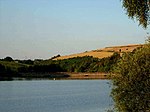Aughton, South Yorkshire

Aughton is a village near Rotherham in South Yorkshire, England, located in the civil parish of Aston cum Aughton, 4 miles (6 km) south of Rotherham. The village setting is rural, being surrounded by fields. The nearest settlements are Guilthwaite in the north, Ulley in the east, Aston in the southeast, Swallownest in the south, and Treeton in the northwest. Major roads are A618 running north–south and B6067 running northwest–southeast which cross in the northern part of the village and share a common alignment along the northern 300 yards (270 m) of Main Street. Aughton was mentioned in 1066 in the Domesday Book as belonging to three Anglo-Saxon lords. By 1086, it had passed to Richard of Sourdeval, whose tenant-in-chief was Count Robert of Mortain.
Excerpt from the Wikipedia article Aughton, South Yorkshire (License: CC BY-SA 3.0, Authors, Images).Aughton, South Yorkshire
Geographical coordinates (GPS) Address Nearby Places Show on map
Geographical coordinates (GPS)
| Latitude | Longitude |
|---|---|
| N 53.36 ° | E -1.32 ° |
Address
S26 4NZ , Aston cum Aughton
England, United Kingdom
Open on Google Maps




